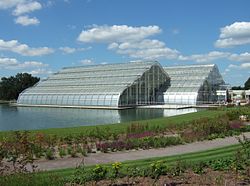Wisley Garden


Wisley Garden is a vast horticultural garden owned and run by the Royal Horticultural Society at Wisley in Surrey. It is one of four gardens run by the Society, the others being Harlow Carr, Hyde Hall and Rosemoor. Wisley is the second most visited paid entry garden in the United Kingdom after the Royal Botanic Gardens, Kew, with 959,434 visitors in the year to 31 January 2010.
History
Wisley was founded by Victorian businessman and RHS member George Ferguson Wilson,[1] who purchased a 60-acre site in 1878.[2] He established the "Oakwood Experimental Garden"[3] on part of the site, where he attempted to "make difficult plants grow successfully". Wilson died in 1902 and Oakwood (which was also known as Glebe Farm[4]) was purchased by Sir Thomas Hanbury,[5] the creator of the celebrated garden La Mortola on the Italian Riviera. He gave both sites to the RHS the following year.
Description
Wisley is now a large and diverse garden covering 240 acres. In addition to numerous formal and informal decorative gardens, several glasshouses and an extensive arboretum, it includes small scale "model gardens" which are intended to show visitors what they can achieve in their own gardens, and a trials field where new cultivars are assessed.
The laboratory, for both scientific research and training, was originally opened in 1907, but proved inadequate. It was expanded and its exterior was rebuilt during the First World War. It was designated a Grade II Listed building in 1985.[4]
Visitor numbers increased significantly from 5,250 in 1905, to 11,000 in 1908, 48,000 in the late 1920s, and 170,000 in 1957, and passed 400,000 in 1978, 500,000 in 1985, and 600,000 in 1987.[4]
In April 2005 Alan Titchmarsh cut the turf to mark the start of construction of the Bicentenary Glasshouse.[6] This major new feature covers three quarters of an acre and overlooks a new lake built at the same time. It is divided into three main planting zones representing desert, tropical and temperate climates. It was budgeted at £7.7 million and opened June 26, 2007.[7]
Features
Wisley has a large number of features, including the following:[8]
- Glasshouse with desert, tropical and temperate climates, and with special topical displays
- Clore Learning Centre
- Alpine houses
- Laboratory
- Plant information centre
- Trials field (where plants are submitted for trial, allowing some to be awarded the prestigious Award of Garden Merit)
- Fruit field, featuring large numbers of apples, pears and other fruit grown in various forms.
- Model gardens, each of a size attainable in gardens attached to houses
- Vegetable garden
- Rock garden and alpine meadow on a sloping site
- Wild garden
- Walled garden
- Canal with water lilies in season
- Battleston Hill, which includes many rhododendrons and azaleas
- Rose borders and mixed borders
- Jubilee arboretum
- Pinetum
- National heather collection
Visitor facilities include cafés and restaurant, car parks, plant centre, etc.
Pictures
-
Orchid in the glasshouse
-
Spring Crocus in flower
-
In one of the alpine houses at Wisley
-
Trials field at Wisley showing some of the hundreds of varieties assessed for the Award of Garden Merit
-
The laboratory
-
Quercus robur beside the laboratory
-
The Butterfly Lovers Pavilion
-
The new Wisley Glasshouse
Outside links
| ("Wikimedia Commons" has material about Wisley Garden) |
- Location map: 51°18’47"N, 0°28’27"W
- Streetmap: TQ064581
- RHS Wisley
References
- ↑ RHS History
- ↑ RHS Garden, Wisley — information on garden history
- ↑ Gardens guide info
- ↑ 4.0 4.1 4.2 Brent Elliott: The Royal Horticultural Society, A History 1804-2004. Published by Phillimore & Co. Ltd. ISBN 1-86077-272-2.
- ↑ Papers within National Archive
- ↑ First turf cut
- ↑ Opening details
- ↑ Visitors' map








